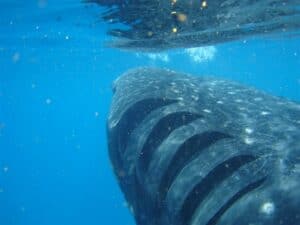There is a lot of speculation about whether sharks have gills and its function. Let us together explore more in this regard.
Sharks have gills, like most aquatic creatures. It helps the sharks derive oxygen from the water that passes over the gills and is then absorbed by small capillaries before being pumped through the rest of the body. In addition, gills help the sharks breathe out carbon dioxide from the body.
Key Takeaways:
| Topic | Key Points |
|---|---|
| Shark Gills and Their Function | – Sharks have gills for respiration, enabling them to extract oxygen from water and release carbon dioxide. |
| – Gills are essential for a shark’s survival as they lack lungs and must obtain oxygen from the surrounding water. | |
| Presence of Gills in Sharks | – All sharks have gills, making them vital respiratory organs just as lungs are for mammals. |
| – Gills are also present in other aquatic animals like fishes and crustaceans. | |
| Location of a Shark’s Gill | – A shark’s gills are typically located on the sides of its head, where water is taken in and gas exchange occurs. |
| – The number of gills may vary among shark species, with most having five, but some may have up to seven gills. | |
| Function of Shark Gills | – Shark gills function similarly to human lungs, facilitating the exchange of oxygen and carbon dioxide. |
| – They absorb oxygen from water, allowing sharks to respire efficiently. | |
| Number of Gill Slits in Sharks | – Sharks typically have around five to seven gill slits on each side of their head, where water exits after oxygen exchange. |
| Number of Gill Openings | – Sharks possess five to seven gill openings, allowing for the easy escape of carbon dioxide and gas exchange. |
| Function of Gill Slits | – Gill slits serve as openings to the gills, aiding in oxygen absorption and carbon dioxide elimination. |
| – They help maintain proper respiration in sharks and are often visible on both sides of a shark’s head. | |
| Shark Swimming and Ventilation | – Some shark species need to keep swimming to ventilate their gills, while others use buccal pumping for respiration. |
| – Buccal pumping is the process of inhaling and exhaling water using cheek muscles, enabling stationary respiration. |
It is through the gills that sharks carry out the respiration process and it plays a crucial role in their sustenance. So, let us address some of the most commonly asked questions on this topic.
Why do sharks have gills?
Sharks have a unique anatomy that helps them navigate deep ocean waters. Let us find out why sharks have gills.
Sharks have gills to help them breathe in the water. Most mammals have lungs that allow them to inhale and exhale oxygen. However, sharks do not have lungs and therefore their gills help them breathe in oxygen that they derive from water and breathe out the carbon dioxide that their bodies produce.
Therefore, gills become an important part of the shark’s anatomical structure and crucial for their survival in the ocean bodies.

Image Credits: Shinji, CC BY-SA 2.0, via Wikimedia Commons
Do all sharks have gills?
Since gills are vital to a shark’s survival, the most common question asked is whether all sharks have gills. Let us answer this for you.
All sharks have gills. They are important respiratory organs, just like lungs are for humans. Without their gills, sharks won’t be able to breathe in oxygen from the water and exhale the carbon dioxide produced in their bodies. Sharks aren’t the only aquatic animals with gills; fishes and crustaceans also have gills.
Sharks need gills to breathe in and out in the ocean. Most aquatic animals rely on their gills to help them breathe in water.
Where is a shark’s gill?

Image Credits: Jaontiveros, CC BY-SA 4.0 <https://creativecommons.org/licenses/by-sa/4.0>, via Wikimedia Commons
While the gills of a fish are easy to locate, have you ever wondered where a shark’s gill is located? Allow us to tell you more in this regard.
A shark’s gill is usually located on the sides of its head. Like most aquatic animals, sharks take in water through their mouth (or spiracles). Once water enters their system, the tiny blood vessels located around the gills work to retain the oxygen and eliminate carbon dioxide produced by the body.
Although all sharks have gills, the number of them may vary from species to species.
Shark gill function
You may be curious to know the way a shark’s gills function. Let us look at the details together.
The gills of a shark have the same function that lungs have for humans. It helps the shark breathe in oxygen and breathe out carbon dioxide. As you might already know, sharks derive oxygen from water instead of air. They take in water through their gills and allow carbon dioxide to escape from their bodies.
The proper functioning of the gills remains vital in sustaining life of aquatic creatures. From fishes to sharks, all marine creatures rely on their gills to take in oxygen.
How many gills do sharks have?
A commonly asked question with regard to shark gills is the number of gills a shark might have. Allow us to tell you more in this regard.
On average, most sharks have five gills. However, some shark species may have up to 7 gills. These gills are present on either side of the shark’s head. The gills of a shark are held in place by gill arches. Some shark varieties like the frilled sharks or sixgill sharks have six gills.
Seven gills is also common among some shark varieties. However, sharks with five gills are the most common.
How many gills do sharks have on each side?
You might be curious to know how many gills a shark may have on either side of their body. Let us learn more in this regard.
Sharks may have around 5 to 7 gills on either side of their head, although most varieties have 5. The number varies as per the shark breed. It is at the gills where gas exchange occurs. For respiration to take place, oxygenated water that enters through the shark’s mouth must continuously flow over the gill filaments.
The Carbon dioxide produced by the shark’s body exits through the gills as well. Therefore, the gills play a vital role in sustaining the process of respiration.
How many gill slits do sharks have?
It goes without saying that gill slits play a crucial role in the respiration process. Let us explore together how many gill slits sharks have.
Sharks can have around 7 gill slits. However, most aquatic species usually have 5 gill slits. There exists capillaries in the gills that absorb oxygen from the surrounding water. Then, water flows across the gill slits continuously to facilitate respiration. These gill slits are visible on either side of the shark’s head.
It is worth mentioning that unlike fishes, sharks do not have flaps covering their gills. Therefore, their gills are easily visible.
How many gill openings do sharks have?
Water from the gills is eliminated through gill openings. Let us find out how many gill openings sharks have.
Sharks have around five to seven gill openings. On the other hand, aquatic creatures like the fishes have four gill openings. These gill openings are present on both sides of the animal’s head. It is through these openings that carbon dioxide can escape from the shark’s body and allows seamless exchange of gasses.
Well-functioning gills and gill slits facilitate a hassle-free respiration process where oxygen enters the shark’s system and the carbon dioxide is eliminated from their bodies with ease.
Shark gill slits function
One of the most commonly asked questions with regards to a shark’s gills is the function of the gill slits. Let us learn more in this regard.
Gill slits serve as openings to the gills. They are found in rays and sharks. Often located in the digestive tract’s pharynx region, gill slits help in the absorption of oxygen from water and the elimination of carbon dioxide from the shark’s body. Sharks usually have 5 to 7 gill slits on each side of their body.
Some sharks have spiracles located between gill slits and eyes that keep the shark ventilated when it is at rest.
Do sharks have to keep swimming all the time?
A common perception is that sharks have to keep swimming all the time to keep themselves ventilated. Let us learn the truth in this regard.
Some shark species have to keep swimming all the time while others don’t. This is because shark species like nurse shark and tiger shark breathe through buccal pumping. However, most shark species like the great white shark or the whale shark lack buccal muscles and hence they have to keep swimming to survive.
For those of you who might not know, buccal pumping is a process in which sharks inhale water using their cheek muscles and draw it into their mouth. Deoxygenated gas also escapes the same way.
Conclusion
Gills are an indispensable part of the shark’s anatomy. Without a proper, well-functioning set of gills, sharks won’t be able to breathe in oxygen from the surrounding water.
The gills of a shark keeps it afloat but they are not the only animals that benefit from gills. Most aquatic creatures rely on their gills to help them breathe in and out. Therefore, gills play a vital role in sustaining life in the aquatic ecosystem.




